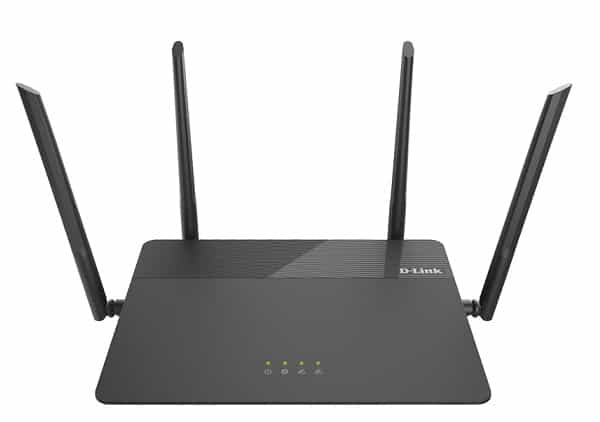Table of Contents
amazon D-Link AC1900 (DIR-878) reviews
The D-Link AC1900 (DIR-878) is an affordable dual-band router that offers the latest 802.11ac technologies, including beamforming and multi-user multi-input, multiple-output data transfer (MU-MIMO). It’s easy to install and manage and comes equipped with four LAN ports, but better-performing routers are on the market for the same price.
Design and Features
The DIR-878 has a matte black finish and measures 1.7 x 7 x 10 inches (HWD). It is designed to be placed on a flat surface or hung on the wall using the two built-in mounting brackets. It has four non-removable, adjustable antennas and has four Gigabit LAN ports, one WAN port and reset, WPS, Wi-Fi, and a power button, all on the back of the cabinet. The top of the Router has LED indicators for power, internet connection, and each radio band. Included in the box is a LAN cable, Quick Setup Guide, and Configuration Card.
The DIR-878 is equipped with an 880MHz dual-core CPU. It’s a dual-band 802.11ac router with speeds up to 600Mbps on the 2.4GHz band and 1,300Mbps on the 5GHz band. It supports the latest 802.11ac technologies, including beamforming, sending signals directly to each client rather than over a broad spectrum, streaming MU-MIMO, delivering data to compatible clients simultaneously instead of sequentially. Smart Connect automatically selects the best radio band for optimal throughput.
Settings and Performance
Installation is very easy. Once the Router connected to my PC and the Internet, I entered http://dlinkrouter.local into my browser’s address bar. I used the Setup Wizard to configure the basic wireless and Internet settings. The whole process takes about three minutes. Then I started generating a unique password and SSID for each band (I disabled Smart Connect to test the 2.4GHz and 5GHz performance separately), and the Router was ready for throughput testing.
The DIR-878 is a good performer, but it didn’t break any speed records in our tests. Its score of 92Mbps on our near-by 2.4GHz throughput test (in the same room) is just a few points behind the Synology Router RT1900ac (95.9Mbps) and Asus RT-AC1900P (98Mbps).
In our 5GHz proximity test, the DIR-878’s 396Mbps score couldn’t beat the competition. The Asus RT-AC1900P achieve 533Mbps, the Synology RT1900ac achieve 479Mbps, and the D-Link DIR-885L/R had a throughput of 572Mbps. TP-Link Archer C7 (V2) achieved 509Mbps in this test. At 30 feet, the DIR-878 clocked in at 268Mbps, beating the Synology RT-1900ac (231Mbps) and the TP-Link Archer C7 AC1750 (V2) Wireless Dual-Band Gigabit Router (250Mbps). However, it falls behind the Asus RT-AC1900P (337Mbps) and the D-Link DIR-885L/R (350Mbps).
We test MU-MIMO throughput using three identical Acer Aspire R13 laptops equipped with Qualcomm’s QCA61x4A MU-MIMO circuit. It should be noted that TP-Link Archer C7 (V2) and Synology RT-1900ac do not support MU-MIMO, which is why they are not included here. The DIR-878 averaged 188Mbps in the proximity test, beating the Linksys EA7500 Max-Stream AC1900 MU-MIMO Gigabit Router (176Mbps), but not the D-Link DIR-885L/R (237Mbps) or Trendnet AC2600 StreamBoost MU-MIMO (TEW-827DRU) (238Mbps). At 30 feet, the DIR-878 came last at 80Mbps. The Linksys EA7500 is just one point higher (81Mbps), while the TrendNet TEW-827DRU (127Mbps) and D-Link DIR-885L/R (165Mbps) are significantly faster.
Conclusion
D-Link’s AC1900 MU-MIMO (DIR-878) Wi-Fi Router is affordable and offers respectable throughput performance, but it’s certainly not the fastest Router in its class. That said, it uses the latest Wi-Fi technology and features a user-friendly control panel that makes it easy to configure QoS for each client, set up parental controls, and configure guest networks. Installation is quick, but it can use a few USB ports to connect external peripherals, such as storage drives and printers.
